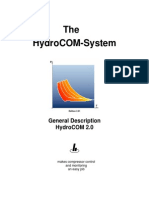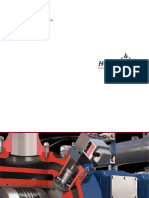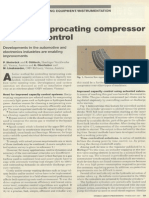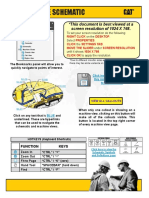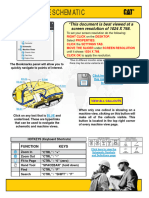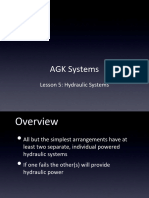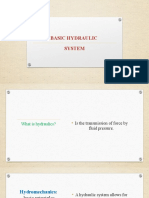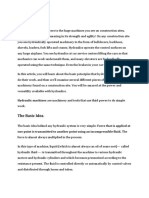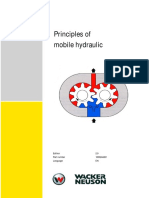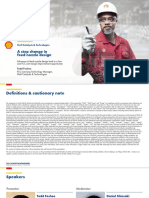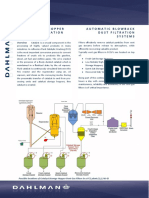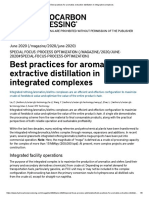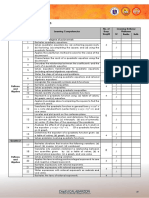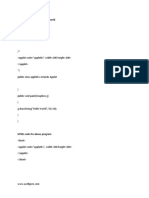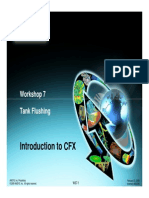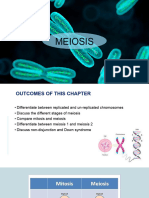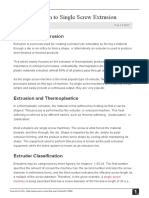Hydrocom General Description
Uploaded by
NaiduJagarapuHydrocom General Description
Uploaded by
NaiduJagarapuHydroCOM
Edition 4.10
General Description
HydroCOM 4.0
General Description 4.10 2010-01-12
1 INTRODUCTION ...................................................................................................3
2 ABBREVIATIONS .................................................................................................3
3 GENERAL FUNCTION..........................................................................................3
3.1 What is HydroCOM? ...............................................................................................................................3
3.2 Functional description ...........................................................................................................................4
3.3 The reverse flow control ........................................................................................................................5
3.4 Control layout .........................................................................................................................................7
3.5 Certificates and approvals .....................................................................................................................8
3.4.1 Explosion protection..........................................................................................................................8
3.4.2 Electromagnetic Compatibility (EMC) and safety of low voltage devices ..........................................8
4 THE COMPONENTS OF HYDROCOM.................................................................9
4.1 HydroCOM actuators..............................................................................................................................9
4.2 Compressor Interface Unit CIU............................................................................................................10
4.3 External Power Supply.........................................................................................................................11
4.4 Isolation Amplifier ................................................................................................................................11
4.5 TDC-sensor ...........................................................................................................................................11
4.6 Hydraulic Unit (HU)...............................................................................................................................11
4.7 HydroCOM Service Software (HSS) ....................................................................................................12
5 INSTALLATION EXAMPLES..............................................................................13
General Description 4.10 2 2010-01-12
1 Introduction
This document describes the functions and equipment of HydroCOM in
general. The equipment delivered may slightly differ from the descriptions in
this document.
2 Abbreviations
The following abbreviations are used throughout this manual
Actuator Device for suction valve control
CIU Compressor Interface Unit
DCS Distributed control system
EPS External Power Supply, 48VDC
GIM General Interface Module
HSS HydroCOM Service Software
HU Hydraulic Unit
IA Isolation Amplifier
IPS Internal Power Supply
PLC Programmable logic controller
SIM Stage Interface Module
TDC Top Dead Center
3 General function
3.1 What is HydroCOM?
The reliable, efficient, flexible compressor control system for optimal use of
resources.
HydroCOM is a hydraulically actuated computerised compressor control
system.
HydroCOM is a system for the stepless capacity control of reciprocating
compressors in a range between (0) 10 -100 %. The minimum continuous
load depends on gas composition, operating conditions and compressor
design parameters. HydroCOM is based on components of the injection
technology for large diesel engines, enhanced by state of the art digital
computing and control technology.
Hydraulically actuated unloaders keep the suction valves open during part of
the compression cycle. Thus part of the gas taken into the cylinder during
the suction cycle is pushed back into the suction plenum. In this way the gas
volume per working stroke can be controlled.
This system saves compression power at part load, since the energy
consumption of a compressor is proportional to the quantity of gas
compressed per compression cycle.
The capacity closed loop control is done by the DCS / PLC or an optionally
supplied loop controller.
HydroCOM provides in addition to control as a standard feature suction
valve nest temperature measurement. Temperature sensors are integrated
in each actuator.
General Description 4.10 3 2010-01-12
3.2 Functional description
The following diagram shows the schematic layout of the HydroCOM:
Fig. 1.: Schematic system layout
All suction valves are equipped with HydroCOM actuators. They perform the
actual control task – delaying the closing of the suction valves at part load.
Hydraulic unit (HU) and hydraulic piping supply the mechanical energy to the
actuators.
The actuators are connected by the HydroCOM-Bus to the Compressor
Interface Unit (CIU). The CIU provides the electronic control of the actuators
and serves as interface between the HydroCOM system and DCS / PLC
where closed loop control is performed.
The communication between DCS, PLC or loop controller and HydroCOM is
based on analog and binary signals. As alternative the on board Modbus
interface can be used.
The TDC-sensor synchronizes CIU with compressor speed and gives
reference of the crank shaft position. The CIU performs the real time
calculation of suction valve opening and closing time and sends the
commands to the actuators. Thus compressor output becomes a simple
analog control variable for the plant operator. By using digital control
technology the HydroCOM system can react within 3 revolutions to change
compressor output. Therefore HydroCOM is the ideal choice for those
applications where fast and precise control is required.
HOERBIGER engineers use the Windows® based HydroCOM Service
Software (HSS) for system configuration. But the HSS is also an
comprehensive user tool for data display and HydroCOM service.
General Description 4.10 4 2010-01-12
3.3 The reverse flow control
The capacity control method is based on the so called reverse flow control
principle. A portion of the gas which was taken into the cylinder during the
suction cycle is pushed back into the suction line during the compression
cycle.
p
Dr
A
pD D
Energy savings at
50% part load
Cr
C
pS
B
V
Fig. 2.: The principle of reverse flow regulation
The above indicator diagram shows the functional principle of HydroCOM.
Cylinder pressure is displayed as pV-diagram. At position C (bottom dead
center, BDC) the compression cycle starts. Without the HydroCOM system,
under full load operation, the gas is compressed immediately after passing
BDC. When the cylinder pressure reaches D the discharge valve opens. The
gas is pushed out of the cylinder. When the piston reaches A (top dead
center, TDC) the re-expansion begins. The gas which due to the cylinder
clearance is still in the cylinder, re-expands. When the cylinder pressure
reaches the suction pressure (B) the suction valve opens and gas is taken
into the cylinder.
The power necessary for the operation of the compressor is proportional to
the area enclosed by the indicator pressure curve.
Check
Check
valve
valve
Solenoid
Solenoid
valve
valve
Hydraulic
Hydraulic
cylinder
cylinder
Hydraulic
Hydraulic
unit
unit
Unloader
Unloader
Suction
Suction
valve
valve
Fig. 3.: HydroCOM Actuator
The suction valve sealing elements are controlled by the unloader. The
unloader is driven by the HydroCOM actuators. In the actuator a fast
switching solenoid is foreseen. Just before suction valve opening the
General Description 4.10 5 2010-01-12
solenoid switches and hydraulic oil flows into the actuator’s hydraulic
cylinder. The high pressure piston moves the unloader downwards the valve
guard. After BDC the unloader delays the closing of the suction valve during
compressor part load. Thus cylinder pressure follows from C to Cr instead of
from C to D. The required power consumption is therefore much lower than
at full load. The slight pressure increase ( C - Cr) is due to pressure losses in
the suction valve. As the gas flows back from the cylinder chamber into the
suction line, the quantity of gas in the cylinder available for compression is
reduced. At Cr the solenoid switches, oil flows out of the hydraulic cylinder,
the unloader moves upwards and the suction valve closes. The compression
follows the line from Cr to Dr.
As shown in the diagram the indicated power for app. 50% load is only about
half of the power required for full load. Thus the principle of reverse flow
regulation saves energy compared to bypass control.
General Description 4.10 6 2010-01-12
3.4 Control layout
The compressor is either controlled by the DCS, PLC or an external loop
controller that may be optionally provided by HOERBIGER.
One of the process variables (e.g. discharge pressure, suction pressure,
flow volume..) is selected as control variable. The user defines a set point for
this variable. A PI-controller is assigned to each stage of the compressor.
The first stage is controlled according to the process variable. The output of
the first controller operates primarily the first stage. The interstage suction
pressures are selected as control variables for the higher stages. The
capacity delivered by each stage is varied by 4..20mA controller signals
which are linked to the CIU. The enclosed basic sketch shows this principle.
A start-up function is to be provided in the controller. It includes the start-up
unloading and start-up ramp for smooth loading of the compressor.
Optionally HOERBIGER may give assistance in the DCS/PLC configuration
or may deliver a programmed ABB loop controller.
DCS
PLS / SPS
Set Point Set Point
PI- PI-
Regler
Controller Regler
Controller
0 – 100 % 0 – 100 %
Start Ramp
Rampe
Skalierung
Scale Skalierung
Scale
1. Compressor Stage
2. Compressor Stage
St Ko St Ko
uf m uf m
Suction Pressure
Suction Pressure
e
1. pr e
2. pr
Sa es Sa es
ug so ug so
1. Stage
2. Stage
dr rst dr rst
uc uf uc uf
k 1.
e k 2.
e
4 – 20 mA 4 – 20 mA
Signal Signal
CIU SIM 1 CIU SIM 2
PT PT
1. Stage
Stufe 2. Stage
Stufe
Fig 4.: principle of suction control
General Description 4.10 7 2010-01-12
3.5 Certificates and approvals
3.4.1 Explosion protection
The compressor must not be operated with other gases than specified at the
time of placing the order. If the compressor shall be operated with other
gases written approval has to be obtained from HOERBIGER.
The certification is based on the directive 94/9/EC (ATEX) - Equipment and
protective systems intended for use in potentially explosive atmospheres.
Standards: electrical apparatus for explosion hazardous location
EN 50014 general regulations
EN 50018 flame-proof enclosure „d“
EN 50019 type of protection "e"
Since most HydroCOM applications are installed in potentially explosive
atmospheres, all components that are to be installed at the compressor are
explosion proof. The explosion protection certification is valid for all gases of
the explosion groups IIA and IIB plus hydrogen. The certificate does not
allow operation with Oxygen or Acetylene.
In detail following protection classes are used:
• Protection class EEx-d is applied to the actuator’s electric housings
where the valve electronics, the solenoid and the hydraulic piston
are placed.
• EEx-e is applied to the connection box and the construction of the
solenoid.
Exception: The connection box for CSA and FM Div. 1 is EEx-d
Conformity with European Directives is based on a type examination by a
Notified Body, the required production tests, and the marking on the device.
Following certifications have been received up to now for the actuator:
EU: ATEX certified :
Electrical Ex-protection: II 2G EEx de IIB+H2 T4
Mechanical Ex-protection: II 2G c
USA (FM): AEx de IIB+H2 T4
Class I, Div. 1, Group B, C, D, T4
Canada: Class I, Div. 1, Group B, C, D (CSA)
Japan: Ex de IIB + H2 T4
3.4.2 Electromagnetic Compatibility (EMC) and safety of low voltage
devices
HydroCOM complies with the EMC regulations and the safety regulations for
low voltage devices.
General Description 4.10 8 2010-01-12
4 The components of HydroCOM
Figure 1 outlines all components and supply lines of the HydroCOM system.
The components are described in the following sections.
• HydroCOM Actuators
• Compressor Interface Unit (CIU)
• External Power Supply (EPS)
• Isolation Amplifier (IA)
• TDC-sensor
• Hydraulic Unit (HU)
• HydroCOM Service & Configuration Software (HSS)
4.1 HydroCOM actuators
The HydroCOM actuators control the valve unloaders and thus control the
compressor suction valves. The hydraulic pressure is supplied by the
hydraulic unit (HU). The actuators are electronically controlled by the CIU via
the real-time HydroCOM field bus. Each actuators is supplied with 48VDC by
the external power supply (EPS).
The actuators comprise of the valve housing, the seal housing and the
electric housing.
Valve
Valve Housing
Housing
Oil
Oil inlet
inlet
Solenoid
Solenoid
Valve
Valve cartridge
cartridge
Soft
Soft touch
touch damper
damper
Oil
Oil outlet
outlet
Piston
Piston cartridge
cartridge
High
High pressure
pressure piston
piston
Seal
Seal Housing
Housing
Leakage
Leakage out
out Electric
Electric Housing
Housing
Flare
Flare connection
connection Connection
Connection boxbox
Wiper
Wiper rings
rings Printed
Printed circuits
circuits incl.
incl.
Guiding
Guiding rings
rings Microcontroller
Microcontroller and
and
Sealing
Sealing rings
rings Valve
Valve driver,
driver,
Temperature
Temperature sensor
sensor Fuses,
Fuses, Bus
Bus Interface
Interface
Unloader
Unloader Rod
Rod
Fig 5.: The HydroCOM Actuator
In the valve housing the 3/2 way valve is actuated by the solenoid and the
retracting spring. Depending on the position of the 3/2 way valve the
actuator piston is either exposed to the pressure maintained by the hydraulic
unit or to atmospheric pressure (tank). The high pressure of the actuator
acts directly on the unloader rod. Up streams of the 3/2 way valve a check
valve is located. During the phase of reverse flow through the suction valve
the hydraulic oil is trapped by the check valve. Consequently the pressure in
the high pressure cylinder can exceed the pressure of the hydraulic unit.
A two stage throttle (soft-touch-damper) is installed in each actuator in order
to protect the moving parts of the unloading system and the valve sealing
elements against excessive impact stress. The soft-touch-damper consists
of a start bypass volume and an orifice. The bypass volume is filled during
the first phase of the closing operation ( 30% to 60% of the valve lift). After
the bypass volume has been filled up the oil pressure increases and
General Description 4.10 9 2010-01-12
dampens the closing of the sealing elements considerably before hitting the
seat.
The seal housing provides the sealing of the unloader rod. Sealing is
performed by a wiper element, several sealing elements and guiding rings.
Between the upper and lower sealing element a ring chamber with flare gas
connection is located.
A temperature sensor is located within this seal housing with the sensing
point very close to the suction valve cover. The suction valve cover
temperature is used for continuous monitoring of suction valves and flow
regulation. The measurements can be transferred via CIU analog outputs or
Modbus interface to the DCS/PLS or HydroCOM-RecipCOM.
During operation some oil may gather at the bottom of the piston. The oil
leakage is tapped by a leakage oil connection into a collecting tank.
The actuator electronics are mounted within the flameproof electric housing
(EEx-d). The electronics control the solenoid, measure the valve nest
temperature and hydraulic pressure (option). Each Actuator is equipped with
a microprocessor to fulfill these tasks. This microprocessor solves drive,
monitoring, and communication functions. The electrical lines (48VDC and
HydroCOM field bas) are connected the EEx-e connection box.
4.2 Compressor Interface Unit CIU
-/+0*.,+0 -/+0*.,+0 -/+0*.,+0 -/+0*.,+0 -/+0*.,+0 -/+0*.,+0
CIU on
TDC 5V
Enable
Code Code Code Simulation
Warning 15V
Error
Phyd low
Scroll/ Scroll/ Scroll/
Clear Clear Clear
HSS HydroCOM
SIM-4 SIM-4 SIM-4 GIM-4 CIU-4 IPS
Fig. 6.: Front view HydroCOM-CIU
The HydroCOM-CIU (Compressor Interface Unit) serves as interface
between the HydroCOM-system and the DCS / PLC. The controller output
defined for each compressor stage is translated into the opening and closing
signals for the suction valves. The valve nest temperatures, measured by
the actuators, are transferred to the DCS / PLC via the CIU. Further the
transmission of enable-, warning-, error- , and simulation signals is effected
by the CIU. The CIU is configured and serviced via the RS-232-Interface.
The interface is mounted on the front of the CIU. The TDC sensor
synchronizes the CIU with compressor speed and crank shaft position. The
CIU calculates the valve actuation timing.
Signals between CIU and the controller can be exchanged via parallel wiring
(hardwired) or Modbus.
The Compressor Interface Unit consists of up to six Stage Interface Modules
(SIM - one for each compressor stage), the General Interface Module (GIM)
and the Internal Power Supply (IPS). The modules are placed in a 19" sub-
rack. Up to eight valves can be controlled per SIM. Head-end and crank-end
valves can be driven independently. There must be one HydroCOM field bus
line to the compressor per SIM. Please refer to the assembly manual for the
specification of the bus cable.
General Description 4.10 10 2010-01-12
4.3 External Power Supply
The External Power Supply (EPS) provides actuators with 48VDC.
4.4 Isolation Amplifier
The isolation amplifier transfers the TDC signal from the hazardous area
(intrinsically safe circuit) to the CIU in the safe area. Input, output and supply
voltage are electrically isolated from each other.
4.5 TDC-sensor
The TDC-sensor synchronizes the HydroCOM system with compressor
speed and determines the position of the crankshaft. Each revolution the
TDC-sensor sends one reference impulse to the CIU. CIU and TDC-sensor
are electrically separated by the isolation amplifier IA.
The TDC-Sensor is a cylindrical, inductive proximity switch according to DIN
19234 (NAMUR).
4.6 Hydraulic Unit (HU)
The Hydraulic Unit supplies hydraulic energy to the actuators. Depending
on the suction pressure of the highest controlled compressor stage the
pump increases oil pressure from atmospheric pressure to up to 200 bar.
The oil is fed to the actuators via hydraulic lines that can be shut-off. There
are pulsation dampers close to inlet and outlet of the valves.
The oil is led back un-pressurized. Besides the oil supply lines a leakage oil
line has to be connected to a separate collector tank. (The specification of
the piping system can be found in the assembly and installation manual).
The drawing below shows the basic design of the hydraulic unit.
Hydraulic oil is pumped via a gear pump into the system. The oil is
connected to the circuits of each stage via redundant high-pressure-filters
with check valves (visual blocking indication).
For each compressor stage one circuit is used. The maximum operating
pressure is maintained through a pressure control valve. Any overflowing oil
is cooled down in a cooler and is sent via a return filter to the tank.
By a built in thermostat the oil cooling circuit will be switched off at low
ambient temperatures to avoid too low hydraulic oil temperatures.
Following additional equipment is integrated in the hydraulic unit:
• Level switch
• Oil pressure transmitter
• Temperature transmitter
Optionally an oil pan can be supplied.
General Description 4.10 11 2010-01-12
Fig. 7.: Hydraulic unit size NG120 (left) und size NG 63 (right)
Return line Supply line
from the Actuators to the Actuators Shut-off ball valves
Feeding line
Shut-off ball valves
Return line Pressure transmitter
PT
Bypass for Pressure gauge
detensioning HU
Switch-over high
pressure double filter
Pollution display
3µm 3µm
Motor
Pressure relief valve
Oil cooler with fan
Thermostat °C
Airing filtre for tank
Pollution display
Filling filtre for tank
M Temperature transmitter
Return filter 10µm
Level switch
10µm TT LS
500µm
max
Oil level display
min
Oil tank Drain valve
Oil pump
Fig .8.: Hydraulic unit principle design
4.7 HydroCOM Service Software (HSS)
The HSS is used for configuration, analysis and service of following
HOERBIGER products:
• HydroCOM
A PC with Microsoft Windows® operation system is required. The system
requirements are specified in the HSS user manual.
General Description 4.10 12 2010-01-12
5 Installation examples
The following picture shows the typical installation of the HydroCOM system
on a double acting, horizontal reciprocating compressor.
Pipes and hoses for the Hydraulic system
Actuator
Wiring
Piping for leakage oil & leakage gas
Fig 9.: Typical HydroCOM installation
The installation of the HydroCOM system includes the following points:
• Installation of the valves and unloaders
• Installation of the Actuators on the suction valve covers
• Installation of the Hydraulic Unit
• Installation of the CIU, EPS, IA within the safe area (in a cabinet)
• Installation of all pipes and hoses
• Installation of the wiring
• Programming of the DCS (or installation of the ABB external loop
controller if ordered from HOERBIGER)
If required HOERBIGER offers turnkey installations.
General Description 4.10 13 2010-01-12
You might also like
- Hydrocom: Experience Real Capacity Control and Energy Savings100% (1)Hydrocom: Experience Real Capacity Control and Energy Savings8 pages
- Hydrocom: High Energy Savings and Excellent ControllabilityNo ratings yetHydrocom: High Energy Savings and Excellent Controllability8 pages
- Better Reciprocating Compressor Capacity ControlNo ratings yetBetter Reciprocating Compressor Capacity Control5 pages
- Electrical Control Hydraulic System Attachment Combined Function CAT329D2 PDFNo ratings yetElectrical Control Hydraulic System Attachment Combined Function CAT329D2 PDF10 pages
- Hydrocom Specification Petronor NP HISA V1 - 0100% (1)Hydrocom Specification Petronor NP HISA V1 - 033 pages
- 349F XE and 352F XE Excavator Hydraulic System - Combined Function, Electronic Control (Interactive), 462-5176-01 (UENR6410)No ratings yet349F XE and 352F XE Excavator Hydraulic System - Combined Function, Electronic Control (Interactive), 462-5176-01 (UENR6410)11 pages
- DesignofEnergyEfficient ISFP Beidaihe 2007 RydbergKENo ratings yetDesignofEnergyEfficient ISFP Beidaihe 2007 RydbergKE8 pages
- Interactive Schematic: This Document Is Best Viewed at A Screen Resolution of 1024 X 768No ratings yetInteractive Schematic: This Document Is Best Viewed at A Screen Resolution of 1024 X 76812 pages
- Describe The Differences Between The Following. Include Diagrams. A. Open Center Hydraulic CircuitNo ratings yetDescribe The Differences Between The Following. Include Diagrams. A. Open Center Hydraulic Circuit7 pages
- ME080 Section 2 - Types of Hydraulic Circuits100% (1)ME080 Section 2 - Types of Hydraulic Circuits55 pages
- TITLE: Hydraulic Double & Pneumatic Automatic Reciprocating CircuitNo ratings yetTITLE: Hydraulic Double & Pneumatic Automatic Reciprocating Circuit13 pages
- Unit 3 - PART 2 OF 3 Control Components in Hydraulic SystemNo ratings yetUnit 3 - PART 2 OF 3 Control Components in Hydraulic System8 pages
- How To Interpret Hydraulic Control Diagrams. Brendan Casey Marian Tumarkin100% (1)How To Interpret Hydraulic Control Diagrams. Brendan Casey Marian Tumarkin7 pages
- Interactive Schematic: This Document Is Best Viewed at A Screen Resolution of 1024 X 768100% (1)Interactive Schematic: This Document Is Best Viewed at A Screen Resolution of 1024 X 76813 pages
- Cat - Dcs.sis - controller336GC PLANO 2 - 111124No ratings yetCat - Dcs.sis - controller336GC PLANO 2 - 11112410 pages
- J4011 - PNEUMATIC & HYDRAULIC (Hydraulic Basic)No ratings yetJ4011 - PNEUMATIC & HYDRAULIC (Hydraulic Basic)43 pages
- Interactive Schematic: This Document Is Best Viewed at A Screen Resolution of 1024 X 768No ratings yetInteractive Schematic: This Document Is Best Viewed at A Screen Resolution of 1024 X 76817 pages
- Interactive Schematic: This Document Is Best Viewed at A Screen Resolution of 1024 X 768No ratings yetInteractive Schematic: This Document Is Best Viewed at A Screen Resolution of 1024 X 76814 pages
- School of Chemical and Biotechnology, SASTRA Deemed To Be University E-Mail IDNo ratings yetSchool of Chemical and Biotechnology, SASTRA Deemed To Be University E-Mail ID2 pages
- DAHLMAN INFO Catalyst Hopper Vent Gas FiltrationNo ratings yetDAHLMAN INFO Catalyst Hopper Vent Gas Filtration2 pages
- Dos and Don'ts of Vapor Line Blind (VLB) - FCC Refinery Training NetworkNo ratings yetDos and Don'ts of Vapor Line Blind (VLB) - FCC Refinery Training Network3 pages
- Best Practices For Aromatics Extractive Distillation in Integrated ComplexesNo ratings yetBest Practices For Aromatics Extractive Distillation in Integrated Complexes8 pages
- 3b - Varieties and Registers of Spoken and Written LanguageNo ratings yet3b - Varieties and Registers of Spoken and Written Language34 pages
- Guidelines For Life Safety Plan (LSP) SubmissionsNo ratings yetGuidelines For Life Safety Plan (LSP) Submissions6 pages
- Contemporary Professional Nursing FinalNo ratings yetContemporary Professional Nursing Final17 pages
- Assignment 8 - Professional Learning PlanNo ratings yetAssignment 8 - Professional Learning Plan8 pages
- Advanced Building System: Resistance Thermal Insulation Energy Saving Fast InstallationNo ratings yetAdvanced Building System: Resistance Thermal Insulation Energy Saving Fast Installation23 pages
- Implementation of Error Detection Mechanism Using NetSimNo ratings yetImplementation of Error Detection Mechanism Using NetSim3 pages
- MEIOSIS POWERPOINT Grade 12 Bio Corrected 2024-1No ratings yetMEIOSIS POWERPOINT Grade 12 Bio Corrected 2024-147 pages
- ServiceManuals LG Fridge GRL257NI GR-L257NI Service Manual100% (1)ServiceManuals LG Fridge GRL257NI GR-L257NI Service Manual128 pages
- Wireless Communications: Principles and Practice 2 Edition T.S. RappaportNo ratings yetWireless Communications: Principles and Practice 2 Edition T.S. Rappaport19 pages
- An Introduction To Single Screw ExtrusionNo ratings yetAn Introduction To Single Screw Extrusion6 pages
- P35 Portable Dewpoint Meter Datasheet 1898 Iss7No ratings yetP35 Portable Dewpoint Meter Datasheet 1898 Iss73 pages

